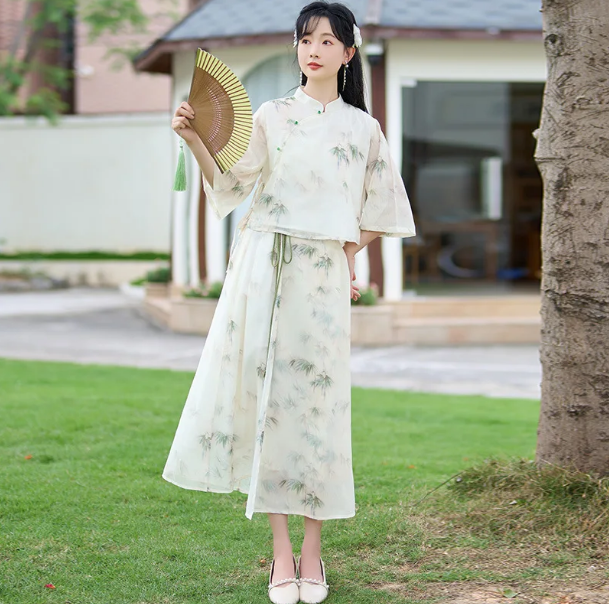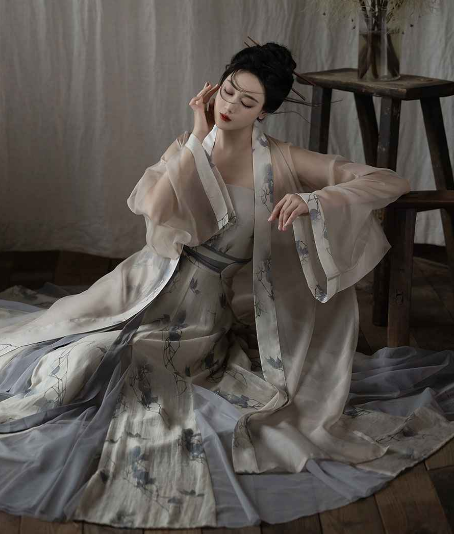Historical Roots of Chinese Clothing
Chinese attire reflects the nation’s evolution, showcasing a journey from simplicity to sophistication. Each dynasty’s fashion chronicles changes in society and culture.
The Origin of Hanfu
Hanfu dates back over 3,000 years, emerging during the Shang and Zhou dynasties. Records like “Book of Songs” mention this attire. It featured a yi, a shang skirt, and a bixi cloth. Nobles wore elaborate silks, while commoners donned plain hemp. Each piece’s color and design would signify the wearer’s status and occasion.
The Emergence of Cheongsam (Qipao)
The cheongsam appeared in the 1920s Shanghai, modernizing the traditional Manchu qipao. This new dress took on silk fabrics and detailed embroideries. It stood out with its form-fitting silhouette and high-cut slits. It rose to prominence among elites and became a national symbol, celebrated in movies and politics.
Both hanfu and cheongsam have left marks beyond China, influencing global fashion. They stand out for their material quality, detailed craftsmanship, and deep cultural significance.

Understanding Hanfu
Hanfu serves as a testament to China’s sartorial elegance and diversity. This traditional attire comes with a distinctive style that has deeply influenced Chinese culture.
Definition and Characteristics
Hanfu, the traditional garb of the Han Chinese, is more than just clothing. It’s a cultural emblem, characterized by its cross-collar, wrapping the right side over the left, and tying with a sash. The attire often includes wide sleeves and a flowing skirt, which together create a silhouette that exemplifies the traditional aesthetics of harmony and balance. Materials range from fine silks for the affluent to simpler cotton for the everyday wearer.
Variations Across Dynasties
As dynasties changed, so did Hanfu styles, echoing the prevailing values and norms. During the Tang dynasty, Hanfu boasted vibrant colors and wide sleeves, reflecting a prosperous and open society. The Song dynasty favored a more subdued elegance, with narrower sleeves and earth-tone colors. In the Ming dynasty, Hanfu saw the addition of standing collars and the popularity of layered robes, each layer meticulously designed to show wealth and status.
These historical variations reflect not only fashion trends but also social and economic conditions, such as trade influences, material availability, and technological advancements in textile production.
The Evolution of Cheongsam
The cheongsam, or qipao, epitomizes the fusion of traditional Chinese aesthetics with modern sensibilities, transitioning from a loose-fitting garment to a tailored fashion statement over time.
Early 20th Century Innovations
In the 1920s, Shanghai’s cosmopolitan influence reimagined the cheongsam with a tighter fit, high-necked collars, and shorter sleeves. This period saw women adopting this style as a statement of both nationality and modernity. Fabrics became lighter and patterns more diverse, often including bright colors and intricate embroideries. This was the era when the cheongsam truly became a canvas for sartorial expression.
Cheongsam in Modern Fashion
Today, the cheongsam is a versatile garment in global fashion, worn at formal events and integrated into daily wear. Designers play with lengths, fabrics, and cuts to suit contemporary tastes while still honoring the cheongsam’s heritage. The modern cheongsam combines classic lines with new materials like stretch cotton and blends, ensuring comfort without sacrificing the traditional elegance. Its timeless appeal continues to resonate, making it a beloved piece for fashion connoisseurs around the world.
The cheongsam’s endurance in the fashion industry underscores not only its cultural significance but also its adaptability to changing times and trends.
Cultural Significance of Traditional Attires
Traditional Chinese clothing like the hanfu and cheongsam carry deep cultural significance, representing millennia of history and serving as emblems of national pride and identity.
Hanfu in Chinese Rituals and Festivities
Hanfu plays a pivotal role in Chinese cultural events, from Spring Festival to traditional weddings. During the Lunar New Year, many opt for hanfu to pay homage to their heritage. The attire also features in Confucian ceremonies and folk dances, symbolizing respect for ancient customs. Each garment worn during these times is rich in symbolism; the colors, patterns, and styles are carefully selected to align with the event’s significance, ensuring tradition threads through modern celebrations.
Cheongsam as a Symbol of Femininity and National Identity
The cheongsam stands as a cultural icon, embodying the grace and elegance of Chinese femininity. It became a staple for women in China, especially during significant political and social movements, reflecting the changing roles of women in society. On National Day and other patriotic events, the cheongsam often appears as a representation of national pride. In international contexts, the cheongsam conveys a strong message of cultural identity, showcasing the unique beauty of Chinese heritage.
The enduring nature of the cheongsam highlights its ability to adapt while maintaining its core identity, as detailed on its Wikipedia page.
These attires are not merely outfits but narratives woven with threads of history, telling stories of a rich past and a vibrant, evolving culture.
Comparing Hanfu and Cheongsam
When contrasting hanfu and cheongsam, one delves into a rich tapestry of Chinese culture, revealing distinct narratives and aesthetic philosophies.
Differences in Style and Occasion
Hanfu boasts a flowing silhouette with robes that wrap around the body, suitable for traditional festivals and rituals. It typically features loose sleeves and varies from one dynasty to another, reflecting the ethos of the era. Cheongsam, known for its form-fitting shape and high slits, is often the choice for formal events and social gatherings, symbolizing modernity and elegance.
Influence on Contemporary Fashion
Both hanfu and cheongsam influence today’s fashion, with hanfu inspiring designs that prioritize comfort and fluidity. Cheongsam has carved a niche in high fashion, its signature cut reimagined by designers for the global runway. Modern adaptations of hanfu and cheongsam blend historical motifs with new-age materials, meeting the tastes of a generation that values both innovation and tradition.
These garments continue to inspire contemporary apparel, proving that historical attire can evolve while still honoring its origins.

The Revival of Traditional Chinese Dress
The resurgence of traditional Chinese attire marks a reconnection with historical roots, celebrating China’s rich sartorial legacy.
The Hanfu Movement
The hanfu movement has ignited a renaissance for traditional Chinese dress among the youth. Advocates of hanfu emphasize its cultural importance and seek to integrate it into daily life. Social media has played a crucial role, with platforms like Weibo and Douyin showcasing hanfu’s versatility and its relevance in modern settings. This movement has not only revived ancient styles but also influenced contemporary fashion, leading to increased demand and production of hanfu-inspired clothing.
Cheongsam in Popular Culture and Global Fashion
Cheongsam has transcended its traditional boundaries to become a global icon. Featured in films, on red carpets, and in fashion shows, it symbolizes both a respect for heritage and a bridge to the world. Internationally acclaimed designers often draw on the cheongsam, modernizing its design while maintaining its classic elegance. The garment’s iconic status ensures that it remains a popular choice for women worldwide, celebrating its timeless beauty and the enduring legacy of Chinese culture.
For a deeper understanding, the Cheongsam Wikipedia page details its international presence.







